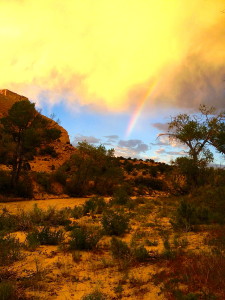 My kayak flipped, and rather than risk getting tangled up in the boat, ladder, and rope and held under water, I abandoned my gear and swam to shore. I had to make a split decision between paddling close to the undercut rock or making a move to the right through the small channel between the ladder and the shore. The water level was ideal to kayak the Ferron Creek, but a high gradient made the water move fast, leaving little time for decision making on the run.
My kayak flipped, and rather than risk getting tangled up in the boat, ladder, and rope and held under water, I abandoned my gear and swam to shore. I had to make a split decision between paddling close to the undercut rock or making a move to the right through the small channel between the ladder and the shore. The water level was ideal to kayak the Ferron Creek, but a high gradient made the water move fast, leaving little time for decision making on the run.
According to the guidebook, the undercut rock was not a hazard. There is plenty of space to right of the river, and we didn’t see the ladder in the water when we scouted from the road. Had we seen the ladder while scouting, we would have been able to plan accordingly. Where did the ladder come from? I decided on a line just to the left of the ladder and right of the rock, but my partner ahead of me pointed to the small channel. At the last minute I tried to change my line. I didn’t make it, and the current turned my boat sideways as I hit the ladder. I flipped and found myself submerged and scrambling for safety.
When in the wilderness, your ability to adapt to circumstances and challenges as the need arises can affect your safety, and the safety of those in your party. While I am not an expert, nor do I claim to obtain a wealth of knowledge in outdoor survival, I have learned a few tricks over the years. While you can’t always control what happens, your response to the situation not only determines your safety, but also your satisfaction with the experience.
- Do the work. One of my greatest joys in life is setting out on an adventure. It can be a road trip, hiking, biking, snowboarding, kayaking, taking a new class, meeting new friends or just returning to a place you know and love with a fresh perspective. Research, gather required gear, and ask for advice before you set out.
- Know your limits. You are the only person that can determine your ability level for an adventure. Don’t get in over your head. Get the experience you need before taking on more challenging adventures. It is not only your safety in jeopardy, but also the safety of the members in your party.
- Surrender your plan if necessary. Taking on new adventures requires flexibility, as it is rare that things go exactly as planned. You know how it goes; you have a plan, you are committed, a hazard arises at the last minute, you change your line at the last minute and pull it off.
- Walk away with grace. At times all the planning and preparation in the world cannot change unplanned obstacles such as weather or gear failure. As hard as it might be, a trip to the local hotel and bar might be the best option.
- Try again! It took me three attempts to be able to backpack Grand Gulch in Southern Utah. The first attempt was foiled by flash floods, the second a wildfire. The third attempt was successful and resulted in a great trip! Decide what trips are worth it, and don’t give up.
Luckily for me, Ferron Creek dumps into a reservoir. I spent the remainder of the day searching for my boat, only to see it dump out at the reservoir. While I only got to paddle a mile or so, my day ended paddling across the peaceful water with a beer in hand to rescue my boat that had its own story of running rapids to tell.

Inspiring stuff, lucidly written too,Shauna… Glad I found my way here… With Best Wishes Scott http://www.scotthastie.com
Thank you, Scott!
Shauna